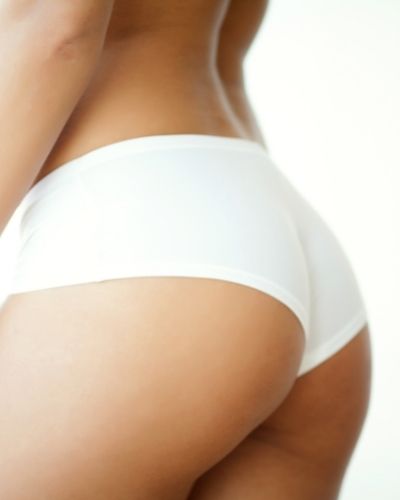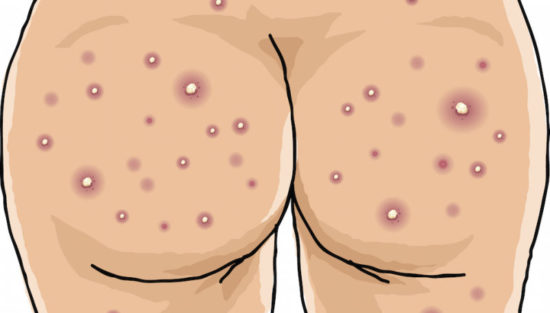All acne is annoying, but there is something particularly embarrassing about having a pimply butt when all you want to do is show off your new swimsuit at the beach.
And although butt acne can be a challenge if not treated properly, it’s actually one of the easiest forms of acne to get rid of.
All you need to do is know its triggers, avoid them, and use very few products to keep it at bay all year round and not just during the summer.
So with all that said, let’s start with the most important thing you need to know about butt acne.
What is Butt Acne?
Butt acne is an inflammatory skin condition known as folliculitis, which means inflamed hair follicles.
Although facial acne and its variants are considered types of folliculitis, these two are not the same conditions.
The most prominent characteristic of folliculitis is a tender red spot, sometimes with a surface pustule, while symptoms usually include mild to moderate itchiness.
Although rarely serious, this condition has the potential to get infected and cause more severe issues, including ingrown hairs that often require surgery to be removed.
And since the treatment is not complicated and doesn’t demand any special care, it’s best to treat it before more serious inflammation happens.
8 Best Ways to Get Rid Of Butt Acne

Here are a few easy ways that will help you get rid of acne on the butt:
Shower After a Workout
Sweat can increase the risk of follicular inflammation, and stale sweat can also lead to fungal infections on the skin.
Therefore, try to shower as soon as you can after a workout.
If you can’t, try to at least change your underwear and wear clean and dry clothes until you can shower.
Avoid Fabric Softeners
Fabric softeners are often linked with allergic reactions and skin conditions such as contact dermatitis and eczema.
Although most fabric softeners are marketed as hypoallergenic, this doesn’t guarantee that they’re not going to irritate the skin, as a single ingredient in any product can cause the skin to react.
Besides that, if you compare a hypoallergenic version to standard fabric softeners – most of them contain the same ingredients, which tells us that the hypoallergenic claim is purely a marketing tactic to make the consumer believe they are using a safer option.
Additionally, if you are currently dealing with folliculitis or butt acne, avoiding fabric softeners altogether may be the best idea, as the waxy particles from a softener can stick to and accumulate on the clothes and cause inflammation.
Sit On a Warm Washcloth
Another useful way to soothe inflammatory butt acne is to place a damp, warm cloth over the area of the cluster.
This will help soften the bumps, soothe the skin, and prep the area for further treatment.
Apply Saltwater Solution
Saltwater can help prevent the spread of fungal infections and may be a helpful option if you are experiencing butt acne while on holiday and don’t have anything else nearby.
Mix one teaspoon of table salt with two cups of warm water, apply the solution to the affected areas with a washcloth, and let it sit for a few minutes to soften and sanitize the area.
RELATED: Can Seawater Help Get Rid of Acne?
Exfoliate With Gentle Acids
Gentle exfoliating acids, such as glycolic, mandelic, and salicylic acid, can unclog the follicles and dissolve the bacterial buildup causing inflammation.
You can use exfoliating acids in the form of cleansers for less irritation or leave-on solutions for a prolonged effect.
On the other hand, avoid any type of physical exfoliation, such as loofahs, brushes, or abrasive scrubs, as these can cause the skin to rupture and spread the infected pus to other areas.
Avoid Heavy Body Lotions
Avoid using heavy creams, body oils, and moisturizers after showering, as these can contribute to pore clogging and trigger inflammation.
Body lotions can also be one of the main causes of back acne as well as pustular pimples in other body areas, such as the legs and lower back, and even acne on hips.
It’s best to give your skin a break from clogging ingredients and see how the condition improves after several weeks.
Doing this alone will give you the best answer on what could’ve potentially caused or worsened the inflammation.
Wear Loose Clothing
Wearing loose clothing made out of natural fabrics can also help soothe butt acne, as it prevents moisture from sweat and oils from being trapped against the skin and causing inflammation.
Natural fabrics, such as cotton or linen, are breathable and allow for airflow to the affected area, promoting healing and preventing further breakouts.
On the other hand, avoid wearing tight clothing that may cause friction and muffle the affected area, worsening the condition.
Stay Away From Pools and Hot Tubs
Chlorine and other chemicals found in swimming pools and hot tubs can irritate butt acne, causing it to become red and inflamed.
Therefore, it is best to avoid these types of environments until the skin has cleared up.
If you do choose to swim or soak in a hot tub, make sure to shower immediately afterward and gently cleanse the affected area with a mild soap to remove any residual chemicals.
It is also important to thoroughly dry the skin afterward to prevent moisture from getting trapped and exacerbating the condition.
Best Butt Acne Treatments
Getting rid of butt acne may take some time and will require making changes in your daily routine to not only treat the existing lesions but prevent new ones from forming and also help fade the scars left by this inflammatory condition.
Here are the best products for butt acne:
PanOxyl – Benzoyl Peroxide Wash
The PanOxyl Benzoyl Peroxide Wash is an effective cleanser for acne-prone skin.
It contains 10% benzoyl peroxide, which helps improve existing acne and prevent new lesions from forming by destroying the airless environment inside a pore where acne-causing bacteria prefer to live.
RELATED: How to Use Benzoyl Peroxide for Acne
La Roche-Posay – Effaclar Medicated Gel Cleanser
The La Roche-Posay Effaclar Medicated Gel Cleanser is a gel cleanser that can be used on the face and body to get rid of clogged pores and folliculitis.
It contains salicylic acid, a gentle exfoliating acid that cuts through the superficial oil and cleanses the pores from the inside out.
Paula’s Choice – Acne Body Spray
The Paula’s Choice Acne Body Spray is an effective body treatment that contains salicylic acid and antioxidants that nourish the skin and help soothe the redness surrounding the affected area.
It also comes in a convenient spray bottle and can be used on any body part where you have inflammatory and even cystic acne.
Avoid spraying this product directly onto your face because you may inhale its contents.
Paula’s Choice – Skin Revealing 10% AHA Body Lotion
The Paula’s Choice Skin Revealing 10% AHA Body Lotion is a lightweight exfoliating lotion that dissolves the bonds between the dead skin cells on the skin’s surface and remove the superficial layers that are protecting the follicular plug.
It will smoothen and hydrate your skin while also minimizing bumpy areas, improving texture, and evening out the skin tone.
Avoid using this product paired up with other products on this list to prevent irritation.
The Ordinary – Glycolic Acid 7% Toning Solution
The Ordinary’s Glycolic Acid 7% Toning Solution is an effective and affordable option to treat post-inflammatory hyperpigmentation, which usually appears as dark spots once acne has healed.
Versed – Weekend Glow Brightening Solution
The Versed Weekend Glow Brightening Solution is another decent option for clearing butt acne scars.
It contains skin-lightening agents such as glycolic acid, lactic acid, kojic acid, and niacinamide to even out the skin tone and fade hyperpigmentation. It also contains azelaic acid, which is famous for improving post-inflammatory redness, which is more prominent in light skin tones.
What Causes Acne On The Butt Cheeks?

Tight Clothing
Tight clothing may not only cause more sweating and friction, which can potentially irritate the skin and trigger follicle inflammation, but it can also push the bacteria that are already on your skin deeper into the pores.
You may want to consider taking a break from skinny jeans, tight leggings, or running shorts and replacing them with looser and more breathable bottoms, such as cotton, to help the skin heal.
Hot and Humid Weather
Many start experiencing increased butt acne severity during summer, as the hot and humid climate causes you to sweat, and since the butt is where the skin is the thickest, this is where folliculitis is going to be most severe.
Bacterial Infections
Sweat is also the main contributor to the overgrowth of the staph bacteria.
Staphylococcus aureus is a bacterium that lives on the skin without causing any issues until the skin’s pH is increased.
Sweat is naturally alkaline, which means it has the ability to increase the skin’s pH, and when this happens, the staph bacteria starts to multiply, which starts to cause issues that can sometimes go deeper than just folliculitis and can result in painful boils.
Additionally, another bacterial infection that can lead to folliculitis and coincidentally runs rampant during summertime is Pseudomonas aeruginosa or simply P. folliculitis, which thrives in inadequately chlorinated warm water such as swimming pools, waterslides, whirlpools, hot tubs, saunas, and steam rooms.
Yeast Infections
The most common yeast to cause folliculitis is Pityrosporum, also known as Malassezia or Malassezia folliculitis (Pityrosporum folliculitis).
This is an itchy acne-like condition that requires a multi-pronged approach to clear, including avoiding moisturizers, discontinuing the use of antibiotics, and incorporating topical antifungal or oral antifungal medication for several weeks.
Ingrown Hair
Ingrown hair, often linked to shaving or bikini wax, can contribute to a condition known as Pseudofolliculitis barbae.
This condition is more common in men who shave their beards; however, it can happen in any area that’s hairy and prone to ingrowns.
It is usually characterized by red or dark bumps that can be itchy, but not necessarily always.
If you tend to get this particular condition due to shaving or waxing, you may wanna consider permanent hair removal with a laser or IPL.
Butt Acne FAQs:
Here are a couple of frequently asked questions regarding butt acne:
How To Get Rid Of Butt Acne Scars?
Butt acne scars appear as dark spots or patches, and while they usually fade on their own after some time, you can speed up the process and get rid of them by using exfoliating lotions and products that contain lightening agents such as niacinamide, hydroquinone, kojic acid, etc.
How To Prevent Butt Acne?
Wearing loose clothes, avoiding poorly maintained pools, blotting excess sweat, applying a warm compress to soften the skin, regular exfoliation with gentle acids, antibacterial agents such as benzoyl peroxide, and frequent showering are all efficient ways that will help you prevent butt acne.

My name is Simone and I am a certified skin specialist. I created this website to teach my readers how to take great care of their skin and I also like to occasionally share my honest opinions on skincare products I’ve tried. You can learn more about me here.
